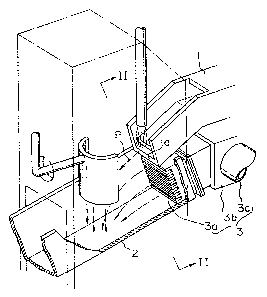Some of the information on this Web page has been provided by external sources. The Government of Canada is not responsible for the accuracy, reliability or currency of the information supplied by external sources. Users wishing to rely upon this information should consult directly with the source of the information. Content provided by external sources is not subject to official languages, privacy and accessibility requirements.
Any discrepancies in the text and image of the Claims and Abstract are due to differing posting times. Text of the Claims and Abstract are posted:
| (12) Patent: | (11) CA 2149801 |
|---|---|
| (54) English Title: | METHOD FOR WATER-GRANULATING CALCIUM FERRITE SLAG |
| (54) French Title: | METHODE POUR LA GRANULATION DE SCORIES DE FERRITE DE CALCIUM DANS UN COURANT AQUEUX |
| Status: | Term Expired - Post Grant Beyond Limit |
| (51) International Patent Classification (IPC): |
|
|---|---|
| (72) Inventors : |
|
| (73) Owners : |
|
| (71) Applicants : |
|
| (74) Agent: | MARKS & CLERK |
| (74) Associate agent: | |
| (45) Issued: | 2003-08-19 |
| (22) Filed Date: | 1995-05-19 |
| (41) Open to Public Inspection: | 1996-03-20 |
| Examination requested: | 2000-06-27 |
| Availability of licence: | N/A |
| Dedicated to the Public: | N/A |
| (25) Language of filing: | English |
| Patent Cooperation Treaty (PCT): | No |
|---|
| (30) Application Priority Data: | ||||||
|---|---|---|---|---|---|---|
|
A method is disclosed for water-granulating calcium ferrite slag which is produced in copper converting processing and contains 10 to 30 weight % of CaO. In the method, water is caused to flow at a flow velocity of 7 to 25 m/sec, and the calcium ferrite slag is introduced into the water flow such that weight ratio of water to slag amounts to no less than 100. With this method, the occurrence of phreatic explosions can be effectively avoided.
Une méthode est divulguée pour la granulation de scories de ferrite de calcium dans un courant aqueux qui est produit lors du traitement de conversions de cuivre et contient de 10 à 30 % en poids de CaO. Dans la méthode, on fait couler l'eau à une vitesse d'écoulement de 7 à 25 m/s, et les scories de ferrite de calcium sont introduites dans l'écoulement d'eau de sorte que le rapport en poids eau/scories s'élève au moins à 100. Avec cette méthode, l'occurrence d'explosions phréatiques peut être évitée efficacement.
Note: Claims are shown in the official language in which they were submitted.
Note: Descriptions are shown in the official language in which they were submitted.

2024-08-01:As part of the Next Generation Patents (NGP) transition, the Canadian Patents Database (CPD) now contains a more detailed Event History, which replicates the Event Log of our new back-office solution.
Please note that "Inactive:" events refers to events no longer in use in our new back-office solution.
For a clearer understanding of the status of the application/patent presented on this page, the site Disclaimer , as well as the definitions for Patent , Event History , Maintenance Fee and Payment History should be consulted.
| Description | Date |
|---|---|
| Inactive: Expired (new Act pat) | 2015-05-19 |
| Inactive: IPC from MCD | 2006-03-11 |
| Inactive: IPC from MCD | 2006-03-11 |
| Grant by Issuance | 2003-08-19 |
| Inactive: Cover page published | 2003-08-18 |
| Amendment After Allowance Requirements Determined Compliant | 2003-06-05 |
| Letter Sent | 2003-06-05 |
| Pre-grant | 2003-06-03 |
| Inactive: Final fee received | 2003-06-03 |
| Amendment After Allowance (AAA) Received | 2003-05-26 |
| Inactive: Amendment after Allowance Fee Processed | 2003-05-26 |
| Letter Sent | 2002-12-03 |
| Notice of Allowance is Issued | 2002-12-03 |
| Notice of Allowance is Issued | 2002-12-03 |
| Inactive: Approved for allowance (AFA) | 2002-11-18 |
| Amendment Received - Voluntary Amendment | 2001-02-12 |
| Letter Sent | 2000-07-18 |
| Inactive: Status info is complete as of Log entry date | 2000-07-18 |
| Inactive: Application prosecuted on TS as of Log entry date | 2000-07-18 |
| Request for Examination Requirements Determined Compliant | 2000-06-27 |
| All Requirements for Examination Determined Compliant | 2000-06-27 |
| Application Published (Open to Public Inspection) | 1996-03-20 |
There is no abandonment history.
The last payment was received on 2003-04-22
Note : If the full payment has not been received on or before the date indicated, a further fee may be required which may be one of the following
Please refer to the CIPO Patent Fees web page to see all current fee amounts.
Note: Records showing the ownership history in alphabetical order.
| Current Owners on Record |
|---|
| MITSUBISHI MATERIALS CORPORATION |
| Past Owners on Record |
|---|
| AKIYOSHI YAMASHIRO |